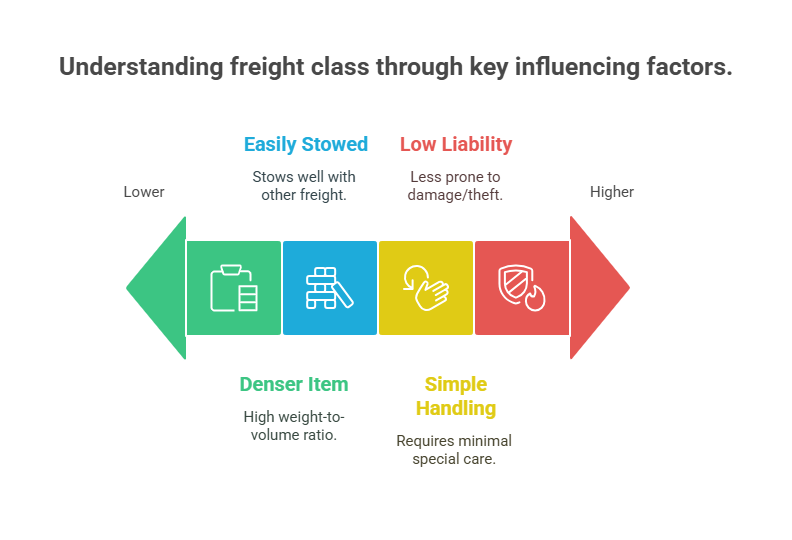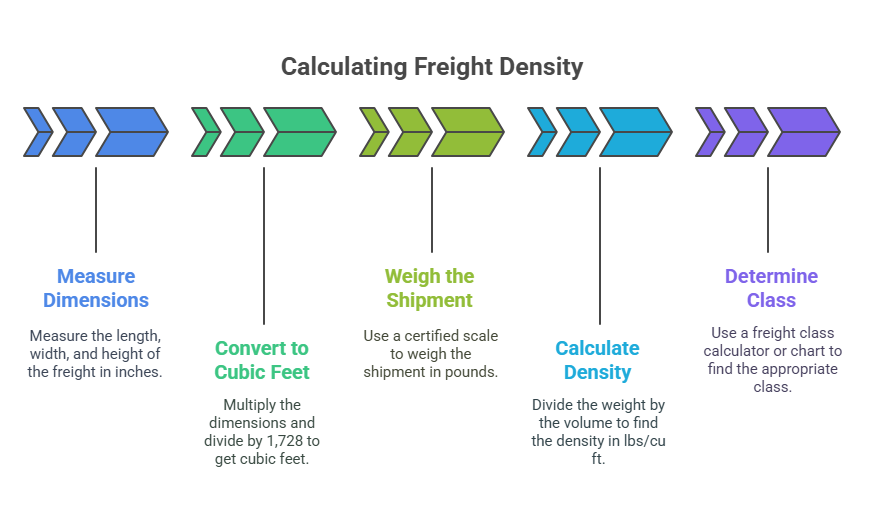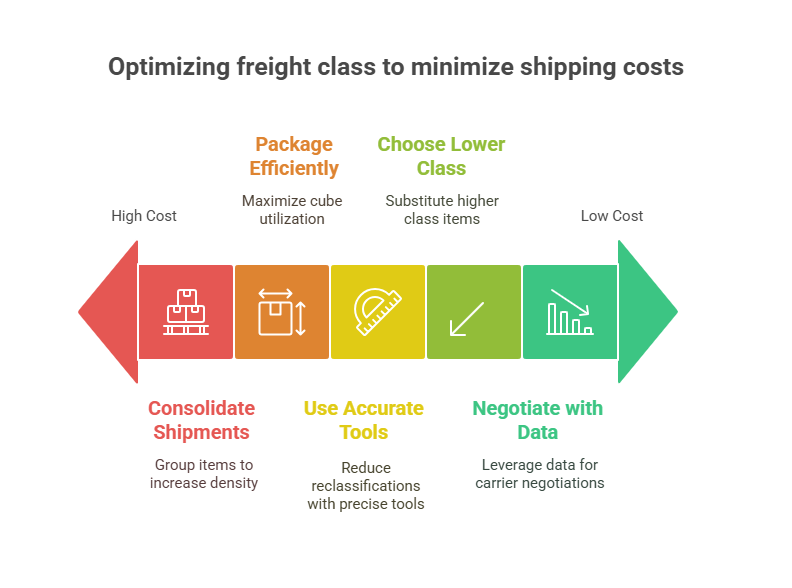Shipping freight efficiently isn’t just about moving goods, it’s about knowing exactly how your freight is classified. With more businesses relying on Less than Truckload (LTL) services, using tools like an XPO density calculator, NMFC code calculator, and pallet class calculator has never been more essential. Whether you’re shipping a single item or managing a large supply chain, understanding freight classification can significantly impact your shipping costs and logistics strategy.
What is a Freight Class?
Freight class is a numeric system created by the National Motor Freight Traffic Association (NMFTA) to classify commodities being shipped via LTL freight. Classes range from 50 to 500, with lower numbers indicating lower costs and higher numbers representing higher costs due to factors like low density or high liability. Calculating this accurately with tools like the freight class calculator or freight class estimator ensures transparency in pricing and compliance with carrier requirements (National Motor Freight Traffic Association [NMFTA], n.d.).
Benefits of Freight Classification
- Cost Efficiency: Proper classification helps avoid overpaying or underpaying for shipments.
- Minimized Disputes: Prevents costly reclassification and disputes with carriers.
- Faster Shipping Quotes: Accurate freight class speeds up quoting and booking processes.
- Regulatory Compliance: Ensures shipments meet industry and carrier standards.
“When freight is properly classified, carriers process shipments faster and with fewer errors, which improves service levels and customer satisfaction.”
What are some specific ways that accurate freight classification has helped your business reduce shipping costs or streamline operations?
Factors Affecting Freight Class
-
Density: The weight-to-volume ratio plays a central role. Use a pallet density calculator or density and class calculator to find the most accurate class.
Example: A dense item like a box of metal bolts will have a lower class (e.g., Class 55) than a large, light item like foam blocks. -
Stowability: Items that are hard to store with others or pose hazards often have a higher class.
Example: A drum of flammable liquid that must be separated from other freight may be given a higher class. -
Handling: Fragile, hazardous, or oddly shaped items may require special care, affecting class.
Example: A fragile glass chandelier requires special handling, increasing its freight class. -
Liability: High-value or theft-prone items increase liability and are typically classified higher.
Example: A pallet of high-end electronics may have a higher class due to theft risk and replacement value.

“Freight class is about more than numbers, it’s about risk, efficiency, and logistics intelligence
Which of the four freight class factors (density, stowability, handling, liability) presents the biggest challenge for your shipping needs and why?
The Role of Density and Class in Freight Classification
Freight density, calculated by dividing the weight of the shipment by its volume, is a key determinant in freight class. A lower density often translates to a higher class, resulting in higher costs. This is why tools such as the NMFC density calculator, pallet density calculator, and freight class density calculator are vital for businesses of all sizes[NMFTA], n.d.).
Companies like XPO offer specialized tools like the XPO density calculator and XPO freight class calculator that make it easier to identify the right class and avoid reclassification charges.
- XPO density calculator: helps you determine your freight’s density by inputting your shipment’s weight and dimensions. This tool then uses that density to estimate the appropriate freight class, saving you time and helping you avoid unexpected costs.
- XPO freight class calculator: goes a step further by allowing users to input not just density data but also product type and packaging information, ensuring an even more accurate class determination tailored to XPO’s carrier requirements (XPO Logistics, n.d.)
“Leveraging proprietary carrier tools not only improves accuracy but also aligns your documentation with carrier expectations, avoiding surprise fees and shipment delays.”
How do you currently calculate density and freight class and what tools have made the biggest difference in your accuracy?
Step-by-Step Instructions to Calculate Freight Density
- Measure Dimensions: Measure the length, width, and height of the freight (in inches).
- Convert to Cubic Feet: Multiply the dimensions together, then divide by 1,728 to convert to cubic feet.
- Weigh the Shipment: Use a certified scale to get the accurate weight in pounds.
-
Calculate Density: Divide the weight by the volume in cubic feet.
-
Example: A pallet measuring 48x40x48 inches with a weight of 500 lbs
- Volume: (48 × 40 × 48) ÷ 1728 = 53.33 cu ft
- Density: 500 ÷ 53.33 = 9.38 lbs/cu ft
-
Example: A pallet measuring 48x40x48 inches with a weight of 500 lbs
- Determine Class: Use a freight class calculator, XPO density calculator, or freight class by density chart to find the appropriate freight class.

“Density calculations are foundational. Even small errors in measurement can skew classification and cost.”
What are some common pitfalls you’ve encountered when calculating freight density, and how did you address them?
Choosing the Right Calculator
There are various calculators available to make freight classification simpler and more accurate:
- XPO Class Calculator: Great for XPO clients who want a streamlined way to calculate shipping class (XPO Logistics, n.d.).
- NMFC Calculator and NMFC Class Calculator: Ideal for identifying standardized NMFC codes for commodities.
- Freight Class Calculator Multiple Pallets: Helps classify grouped pallet shipments accurately.
- Rate Class Calculator: Useful for determining applicable freight rates by class.
Using these tools together, such as an XPO density calculator alongside a freight class calculator for multiple pallets, can make a significant difference in your shipping efficiency.
“Every dollar saved on freight can be reinvested into your supply chain. Smart shippers optimize packaging and leverage data-driven negotiations.”
Looking for the right calculator to optimize your shipping costs? Explore our shipping services to find the best-fit tools and support for smarter, more cost-effective freight classification.
How to Use a Freight Class Calculator for Multiple Pallets
When shipping multiple pallets, using a specialized freight class calculator for multiple pallets ensures each piece is properly classified. This type of tool takes into account combined weight and volume to calculate overall density. The pallet class calculator and freight shipping class calculator are especially helpful in this context, offering bulk analysis that still maintains precision(Freightquote,n.d.).
A class calculator tailored for multiple pallets not only saves time but also minimizes costly reclassification errors.
“For high-volume shippers, multi-pallet calculators are a game-changer. Consolidated shipping boosts efficiency and reduces margin for classification error.”
Tools to Help You Estimate and Look Up Freight Class
Even if you don’t have exact dimensions or weights upfront, a freight class estimator can give you a good idea of what to expect. Similarly, a freight class lookup tool allows you to check the NMFC code and corresponding class for various items.
If you’re unsure, start with a free freight class calculator or a determining freight class calculator to get an initial estimate. These tools often integrate seamlessly with LTL booking platforms to streamline your shipping process.
Here’s a breakdown of the most commonly used freight calculators:
- Free Freight Class Calculator: A cost-effective tool to get a rough estimate of your freight class using basic inputs like weight and dimensions. Ideal for first-time shippers.
- Freight Class Estimator: Offers more intelligent guesses when you lack complete shipment data. Useful during early logistics planning..
- Freight Class Lookup: Lets users enter a product type or NMFC code to instantly view its assigned freight class. Perfect for confirming product classifications.
- NMFC Code Calculator: Matches product descriptions with their corresponding NMFC codes and classes. Often used to validate freight documentation[NMFTA], n.d.).
- NMFC Calculator: Similar to the above, streamlines code identification for shipping and billing accuracy.
- NMFC Class Calculator: Aids in selecting the correct class for commodities with multiple NMFC designations.
- Pallet Class Calculator: Designed to calculate freight class for standard palletized items. Useful for warehousing and fulfillment centers.
- Pallet Density Calculator: Calculates freight density based on pallet dimensions and weight to determine the appropriate class.
- Rate Class Calculator: Calculates the freight class and estimates rate brackets based on dimensions, weight, and commodity.
- Freight Class Calculator for Multiple Pallets: Tailored to handle multiple pallets by calculating total density and class. Great for bulk shipments.
- Freight Shipping Class Calculator: Helps determine the correct class for general LTL freight. Works well with both standard and irregular items.
- Freight Class Density Calculator: Focuses specifically on density-related classification. Ideal when weight-to-volume ratio is the biggest factor.
- Shipping Class Calculator: A general tool useful for both novice and experienced shippers needing classification assistance.
- LTL Class Calculator: Targets shippers using LTL services with a class-focused interface. Helps align with LTL carrier standards.
These tools often integrate with LTL booking platforms to streamline your shipping process.
“Freight class estimators are ideal for planning shipments in the quoting or product staging phase.”
Need to simplify freight classification and streamline payouts? Check out our carrier payment tools designed to save time, boost accuracy, and keep your cash flow moving.
How to Use Freight Class to Lower Shipping Costs
- Consolidate Shipments: Use a freight class calculator for multiple pallets to group items and reduce total class through increased density.
Example: Combining three low-density pallets into one dense unit can shift your class from 150 to 85.
- Package Efficiently: Maximize cube utilization to improve density. Tools like a pallet class calculator help evaluate packaging impact.
Example: Redesigning product packaging to fit more units per pallet decreased a shipper’s average freight class.
- Use Accurate Tools: Avoid estimation errors with a free freight class calculator or XPO freight class calculator to reduce costly reclassifications.
Example: A shipper using a manual system faced regular billing corrections until switching to a class calculator.
- Choose Lower Class Items: When possible, substitute higher class items with those in lower classes to reduce total cost.
Example: Replacing plastic barrels with stackable crates lowered both class and volume.
- Negotiate with Data: Use data from a rate class calculator or NMFC calculator to back your carrier rate negotiations.
Example: Presenting shipping history and classification accuracy data helped a business win better LTL rates.

“Every dollar saved on freight can be reinvested into your supply chain. Smart shippers optimize packaging and leverage data-driven negotiations.”
Which of these strategies have you used successfully to lower shipping costs, and which would you like to explore further?
Frequently Asked Questions (FAQs)
1. What happens if I misclassify my freight?
If you misclassify your freight, the carrier may reclassify it and charge additional fees. This can lead to billing delays, disputes, and higher overall shipping costs.
2. Can freight class change depending on the carrier?
While freight class is standardized by the NMFTA, some carriers use proprietary tools or rules that might influence how they interpret certain classifications especially for specialty or hazardous shipments.
3. Are online freight class calculators accurate?
Most reputable calculators are quite accurate if you provide precise weight and dimensions. Always double-check measurements and use carrier-endorsed tools when available for the best results.
Streamline Your LTL Strategy
Whether you’re a shipping novice or a logistics pro, using the right tools, from an XPO density calculator to a class calculator for shipping, can make a big impact on both cost and efficiency. As freight needs grow more complex, relying on calculators like the NMFC code calculator, pallet class calculator, and rate class calculator ensures you’re not leaving money on the table, or risking shipment delays.
Ready to ship smarter? Integrate freight classification tools into your logistics workflow today, and watch your accuracy, speed, and savings rise.
Reference
Freightquote. (n.d.). LTL freight rates and quoting. Retrieved from https://www.freightquote.com
National Motor Freight Traffic Association. (n.d.). Freight classification guide. Retrieved from https://www.nmfta.org
XPO Logistics. (n.d.). Freight tools and density calculator. Retrieved from https://www.xpo.com




